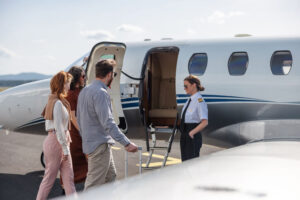Part 135 Company Application Process
Becoming a Part 135 operator is a rigorous process that requires meeting strict FAA regulations for air charter and commuter operations. Whether you plan to operate a single-pilot charter or a full-fledged jet fleet, understanding the different types of Part 135 operations and the FAA’s five-phase certification process is essential.
Types of Part 135 Operations
Before starting the application process, you must determine the type of Part 135 operation you plan to run. The FAA categorizes operators based on complexity and the type of aircraft used:
- Single-Pilot Certificate – For operators who will fly solo, with no additional pilots under their certificate.
- Basic Certificate – Allows for a small team of pilots (no more than five) and a limited number of aircraft (no more than five).
- Standard Certificate – Required for more complex operations involving multiple pilots, aircraft, and routes, such as air taxi and cargo services.
- Commuter Certificate – For scheduled passenger-carrying operations with at least five round trips per week on at least one route.
The Five Phases of FAA Certification
The FAA Part 135 certification process is broken into five phases, each requiring extensive documentation, compliance checks, and FAA approval:
- Pre-Application Phase
- Contact the local FAA Flight Standards District Office (FSDO) to express your intent.
- Complete the Pre-Application Statement of Intent (PASI) to provide basic details about your proposed operation.
- The FAA determines eligibility and assigns an FAA Certification Team to guide you.
- Formal Application Phase
- Submit a detailed Formal Application Package, including:
- Operational manuals (General Operations Manual, Training Manual, Maintenance Manual)
- Pilot and maintenance personnel qualifications
- Proof of aircraft ownership or lease agreements
- FAA reviews your submission to ensure it meets Part 135 requirements.
- Document Compliance Phase
- The FAA thoroughly examines all submitted documents.
- Any deficiencies must be corrected before moving forward.
- Operators must demonstrate compliance with operating procedures, maintenance, and safety standards.
- Demonstration and Inspection Phase
- The FAA conducts on-site inspections of:
- Your operational base
- Aircraft
- Maintenance procedures
- Training programs
- Pilots and crew must pass check rides and operational evaluations.
- Certification Phase
- If all requirements are met, the FAA issues an Air Carrier Certificate, officially authorizing your Part 135 operations.
- Operators can now legally conduct charter or commuter flights under Part 135 regulations
Final Thoughts
Starting a Part 135 company is a lengthy and detail-oriented process that requires careful planning and regulatory compliance. From choosing the right type of operation to navigating the FAA’s five-phase certification process, new operators must ensure they meet all requirements before launching. Consulting with experienced aviation professionals and staying organized with FAA compliance documentation will significantly improve the chances of a successful certification.
RELATED CTS TRAINING










